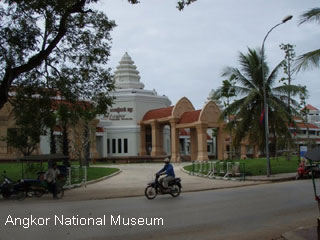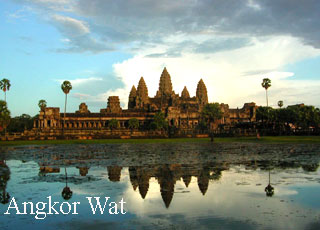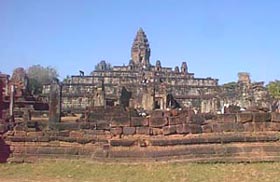Home
Booking your trip to Kratie
Contact email: event-organize@live.com
Tel: (+855)17 44 70 78
Kratie Informations or
 Kratie is one of Cambodia’s eastern provinces with less population, who make their lives on the riverbanks of the Mekong. Beyond the riverbanks it is a remote place with almost no population and thick-forested areas to calm down. The provincial capital is also called Kratié and lies also on the banks of the mighty Mekong River, which emboss the province from the North to the South.
Kratie is one of Cambodia’s eastern provinces with less population, who make their lives on the riverbanks of the Mekong. Beyond the riverbanks it is a remote place with almost no population and thick-forested areas to calm down. The provincial capital is also called Kratié and lies also on the banks of the mighty Mekong River, which emboss the province from the North to the South.

The stretch of the river around Kratié town is home to a group of rare sweet water Irrawaddy dolphins. Therefore the dolphins are the main tourist attraction of the province and the town. The river also has hundreds of Green Island, and circling water, which are also attracting some tourists.
Kratie town is sleepy but picturesque with sandbars and big islands out front and bends in the river. Unlike in many towns around Cambodia, the war years were fairly kind to the French architecture and the roads, at least in the town itself. There are some nice-looking homes of French and Khmer style scattered about, adding to the pleasant feel of the place. You’ll also find a bustling market which is a great place to watch frogs being skinned (and escaping first through the holes in the nets), sample some delicious foods (such as freshly grilled corn cakes) and generally take in rural Cambodian life.

The rare freshwater Irrawaddy dolphins make their home in the Mekong River, just north of Kratie. With only around 120 remaining, they are surely worth a visit. Whether you are just on a trip seeing the river towns along the Mekong or taking a full circuit trip around the east and northeast, Kratie is a nice place to spend a night or two. The river scene of Kratie has a beautiful river boulevard with dozens of snack and drink stands in the late afternoon and evening, making this a nice spot to chill out and watch the people parading by. There are also a few big concrete decks along the river scene. The river road is a great place for a stroll or jog. Enjoy the dramatic sunsets over the Mekong.
PHNOM SAMBOK RESORT

Is the natural and historical resort, locates at Thmor Kre Commune, Kratie District in 11-Kilometer distance from the provincial town by the National Road No 7, then turning more
500 Meters to the mountain. Phnom Sam Bok is the cultural and main tourist resort of Kratie province. The resort has good location and assured safety for tourists to visit. Phnom Sam Bok has been arranged as the tourist resort since the Sang Kum Reas Ni Yum time. The special features of Phnom Sam Bok are:

- Closed to the western mountain foot, there is a big pond full of clearwater and natural plants.
- The mountain has two peak, a dull peak and a pointed peak. On the mountain top, we can view the beautiful scene especially the Mekong River.
- The mountain rich in big trees and birds.
- There is a concrete stair stretching from the mountain foot to the top, and there are many resting place at the mountain.

The legend said that one upon the time, there was a king named Cha Krey Sara Varman a son of Preah Bat Hathak Athi Reah Varman. After he was on throne instead of his father, he informed officials and high officials to find where having gold mine. Then they found a place closed to the mountain foot of Sam Bok very rich in gold. The local people there called the place “Kan Leng Sam Bo Meas” means “a place very rich in gold ”. Long time after that, the word changed to “Phnom Sam Bok Meas ”, then only “Phnom Sam Bor” until now.

The background of Phnom Sam Bok: At the beginning of 15th century, there was a monk named Neak Voan, the student who has the same teacher to the monk, Neak Sen. Neak Sen is the teacher of crocodile, Nen Thun and he does meditation on the mountaintop of Sam Bok. The monk, Neak Voan has very strong ritual formulas and he is well known to the near and far local people. The local people accompany each other to learn the ritual formulas from Neak voan. Since that, Phnom Sam Bok becomes the worshipping place until now.
KAMPY RESORT

Is the great natural resort providing shelter to Dolphins. When we travel along the National Road No.7 to the North about 15 Kilometers from the provincial town, we will arrive at a bridge of Prek Kam Py where we have seen a very novel view of the Mekong River consisting of thousands of islands full of green water plants. Usually from January to May, there are local and international visitors, who call on the Kam Py resort for swimming, especially during the Khmer New Year.

Kam Py resort has special features such as: - The resort is closed to the National Road, assured safety and has large parking sites for motocycles and cars. - The riverbank is full of sand, and there are many islands assuring the visit of thousands of visitors. - The water is clear as mirror, has 0.5-1.30 meter depth and flows with undangerous speed. Kam Py resort has not only the good natural manner, but also been provided the good servises for visitors such as the crossing bridge, floating cottages, soft-drink shops, restaurants, emergency agency, guards and security as well. Nowadays, the provincial tourist office has endeavored to upgrade arranging the resort to be better and more attractive.
SAMBOR TOWN

 Sambor Town For a nice ride through the countryside hugging the Mekong River, you can head north past Phnom Sambok and past the dolphin site. About 24 km from the Globe circle, you come to a fork in the road. The road to the right goes to Stung Treng, but you want to follow the road to the left. This is the better of the two roads and the one that hugs the river to Sambor town, another 11 km away. Stay left at the fork as you near the town and you wind your way to Wat Sambor, located near the river. The front temple is fairly new, with a one hundred-year-old temple just beyond the rear of that temple. The town is pleasant and food, drinks, and fuel are available. As for the ruins shown on the official Cambodia map (south of Sambor), there is nothing left of them anymore. Just one good- luck stone is all that the locals saved, putting it in a thatched temple hut a kilometer off the road. Wat Sray Sahn-tah-rah-boh it’s a big name for a small temple on the river road.
Sambor Town For a nice ride through the countryside hugging the Mekong River, you can head north past Phnom Sambok and past the dolphin site. About 24 km from the Globe circle, you come to a fork in the road. The road to the right goes to Stung Treng, but you want to follow the road to the left. This is the better of the two roads and the one that hugs the river to Sambor town, another 11 km away. Stay left at the fork as you near the town and you wind your way to Wat Sambor, located near the river. The front temple is fairly new, with a one hundred-year-old temple just beyond the rear of that temple. The town is pleasant and food, drinks, and fuel are available. As for the ruins shown on the official Cambodia map (south of Sambor), there is nothing left of them anymore. Just one good- luck stone is all that the locals saved, putting it in a thatched temple hut a kilometer off the road. Wat Sray Sahn-tah-rah-boh it’s a big name for a small temple on the river road.
THE 100-COLUMN PAGODA
 Located at Sam Bor District in 36-kilometer distance, North of the provincial town by the National Road No 7. The special features of Sar Sar-100 pagoda are:
Located at Sam Bor District in 36-kilometer distance, North of the provincial town by the National Road No 7. The special features of Sar Sar-100 pagoda are:The 100-column pagoda was built on the place where the Royal Palace temple of Sam Phu Borak Capital of the Chen La time located. At the area, there are four-Buddist temples facing to different directions:
- Vihear Lao faces to the West
- Vihear Sar Sar-100 faces to the North
- Vihear Kork Keut faces to the Est
- Vihear Kork faces to the South (this Buddhist temple has only base and mark remain).
During the Khmer New Year, the local people who live near the former sam Phu Bo Rak Capital usually celebrate the four-day festival by starting at Vihear Sar Sar-100 first, then Vihear Kork and Vihear Lao lastly.
Background of Vihear Sar Sar-100: Was built in 1806 and the size is 30 Meters x 30 Meters. In the former time, at the 100th column, was thatched by Preah Ang Chan Reachea II for dedicating to the power of Vihear sar sar-100 to maintain the soul of Preah Neang Varakak, his daughter who was swallowed by the crocodile, Nen Thun. Vihear Sar Sar-100 is different to other temples because it faces to the North. About 100 years later, the temple was damaged by the strong lightening, which caused 22 columns burnt down and the statues dirtied by smoke.
Because of this incident, the temple was pulled down and rebuilt by the local people, but it had only 78 columns. Until 1987, the 100-column pagoda has once again been renovated with 35-meter length, 18-meter width, 23-meter height and 116 columns; also, the temple has completely been renovated, inaugurated and Sey Ma buried on January 14, 1998.
 Siem Reap province is located in northwest Cambodia. It is the major tourist hub in Cambodia, as it is the closest city to the world famous temples of Angkor (the Angkor temple complex is north of the city). The provincial capital is also called Siem Reap and is located in the South of the province on the shores of the Tonle Sap Lake, the greatest sweet water reserve in whole Southeast Asia. The name of the city literally means Siamese defeated, referring to the victory of the Khmer Empire over the army of the Thai kingdom in the 17th century.
Siem Reap province is located in northwest Cambodia. It is the major tourist hub in Cambodia, as it is the closest city to the world famous temples of Angkor (the Angkor temple complex is north of the city). The provincial capital is also called Siem Reap and is located in the South of the province on the shores of the Tonle Sap Lake, the greatest sweet water reserve in whole Southeast Asia. The name of the city literally means Siamese defeated, referring to the victory of the Khmer Empire over the army of the Thai kingdom in the 17th century.









































